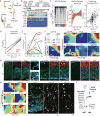Spatiotemporal gene expression trajectories reveal developmental hierarchies of the human cortex
- PMID: 29217575
- PMCID: PMC5991609
- DOI: 10.1126/science.aap8809
Spatiotemporal gene expression trajectories reveal developmental hierarchies of the human cortex
Abstract
Systematic analyses of spatiotemporal gene expression trajectories during organogenesis have been challenging because diverse cell types at different stages of maturation and differentiation coexist in the emerging tissues. We identified discrete cell types as well as temporally and spatially restricted trajectories of radial glia maturation and neurogenesis in developing human telencephalon. These lineage-specific trajectories reveal the expression of neurogenic transcription factors in early radial glia and enriched activation of mammalian target of rapamycin signaling in outer radial glia. Across cortical areas, modest transcriptional differences among radial glia cascade into robust typological distinctions among maturing neurons. Together, our results support a mixed model of topographical, typological, and temporal hierarchies governing cell-type diversity in the developing human telencephalon, including distinct excitatory lineages emerging in rostral and caudal cerebral cortex.
Copyright © 2017 The Authors, some rights reserved; exclusive licensee American Association for the Advancement of Science. No claim to original U.S. Government Works.
Figures




Comment in
-
A mixed model of neuronal diversity.Nature. 2018 Mar 22;555(7697):452-454. doi: 10.1038/d41586-018-02539-4. Nature. 2018. PMID: 29565398 No abstract available.
References
Publication types
MeSH terms
Grants and funding
LinkOut - more resources
Full Text Sources
Other Literature Sources
Molecular Biology Databases

